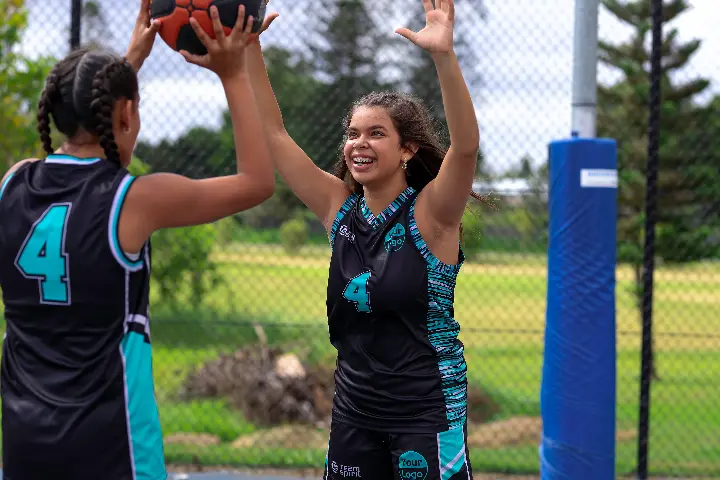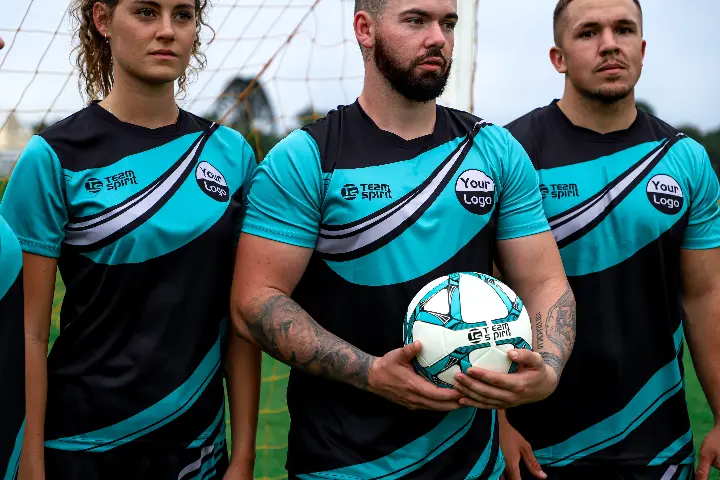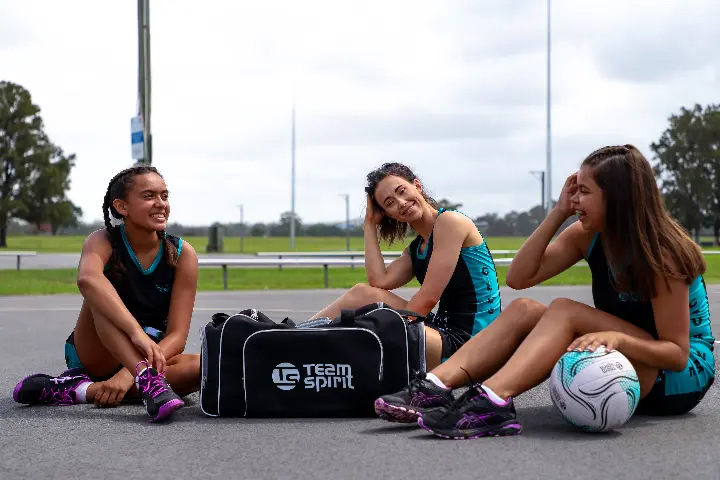When it comes to choosing sports uniforms that actually perform, few materials stand out like mesh fabric. From school athletics to weekend club matches, the right fabric can be the difference between a comfortable, confident team and one distracted by sweat, heat, and poorly fitting kit.
In Australia’s diverse and often unforgiving sporting climate, where many events are held outdoors and in high temperatures, breathability is no longer optional. That’s why mesh fabric has become a cornerstone of sportswear design.
In this guide, we’ll explain what mesh fabric is, why it’s so essential in modern teamwear, how different types are used, and what to consider when choosing the right fabric for your team’s needs.
What Is Mesh Fabric, Exactly?

Mesh fabric is a lightweight, breathable textile constructed with an open-knit or woven structure. Unlike traditional fabrics that feature a tight weave, mesh is intentionally designed with small holes or perforations throughout its surface. These openings serve a functional purpose: they allow air to pass through freely and help moisture evaporate faster.
Most mesh fabrics used in sportswear today are made from synthetic fibres such as polyester, nylon, or elastane blends. These materials are selected for their durability, stretch, and quick-drying capabilities. When combined with the mesh structure, they create garments that regulate body temperature more effectively than solid-weave fabrics.
There are also numerous variations of mesh, some with larger holes for enhanced ventilation, others with a finer weave for modesty or style. Choosing the right type often depends on the sport, intensity level, and even the age group of your players.
In essence, mesh isn’t just a type of fabric, it’s a technology built around athletic needs. Its construction supports airflow, flexibility, and comfort, all without sacrificing durability or aesthetic quality.
Why Mesh Is a Game-Changer for Sportswear
You might not always notice mesh fabric, but you’ll definitely feel the difference when it’s missing. Here are the top reasons mesh fabric continues to dominate the custom sportswear landscape in Australia and beyond:
It Keeps You Cool, Naturally
Mesh fabric’s open structure is designed to improve airflow across the body. This makes it particularly effective during warm-weather training, competitive play, or outdoor school sports carnivals. When players are active in the sun, a poorly ventilated uniform can trap heat and raise the risk of overheating or fatigue. Mesh works by creating a natural cooling effect, helping the body maintain a safe and efficient temperature.
It Wicks Moisture for Better Comfort
Beyond airflow, many mesh fabrics are treated with moisture-wicking finishes. This means they actively pull sweat away from the skin, transporting it to the fabric’s outer layer where it can evaporate quickly. The result? A drier, more comfortable experience throughout the game or workout. For athletes prone to chafing or skin irritation, moisture-wicking mesh is a non-negotiable feature.
It’s Lightweight Yet Strong
One of the reasons mesh is so widely used is its balance of low weight and high performance. It doesn’t weigh athletes down or restrict movement, making it ideal for sports like basketball, soccer, AFL, and netball. At the same time, high-quality mesh is built to handle the physical demands of gameplay, sliding, jumping, diving, without tearing or stretching out of shape.
It’s Fast-Drying and Low-Maintenance
Busy clubs and schools need kits that’s easy to manage. Mesh fabrics dry quickly, making them ideal for environments where uniforms are washed and reused multiple times per week. Whether you're dealing with limited laundry turnaround or unpredictable weather, fast-drying mesh keeps your gear rotation running smoothly.
It Withstands Repeated Wear and Wash
Many people assume breathable fabrics are delicate, but high-performance mesh, especially those with anti-pilling and shape-retention treatments, is surprisingly robust. These garments hold their structure, resist fading, and retain performance properties even after dozens of washes, making them a solid investment for long-term use.
Types of Mesh Fabrics Commonly Used in Sportswear

Mesh is a category, not a single product. Each variation is engineered for specific performance needs, some prioritising airflow, others focused on resilience or sun protection. Understanding these differences can help you choose the most suitable material for your team’s uniforms, training gear, or school sportswear.
Here are the most common types of mesh fabric used in high-performance sportswear today:
Open-Hole Mesh
Open-hole mesh is the classic choice for athletic uniforms. Recognisable by its visibly large perforations, this fabric maximises airflow and allows body heat to escape quickly, making it ideal for high-exertion activities or summer sport.
Because of its structure, open-hole mesh excels in moisture evaporation, helping sweat dry faster and reducing the risk of overheating. This is especially important in sports such as basketball, athletics, and rugby league, where intensity levels and external temperatures are both high.
Team Spirit Sports’ TS Holes Mesh is a high-grade version of this style, combining lightweight construction with durability and quick-drying properties. It’s a popular choice for custom sportswear such as singlets, jerseys, and warm-weather training apparel that needs to breathe without breaking down after repeated use.
Best used for: Basketball singlets, athletics tops, sublimated jerseys, warm-weather training kits.
Eyelet Mesh
Eyelet mesh features smaller, more evenly spaced perforations, giving it a finer texture while still delivering solid breathability. It’s a step up in comfort from more open meshes and often chosen for garments that require a cleaner finish or a smoother feel against the skin.
Because of its tighter knit, eyelet mesh is less transparent and holds shape better, making it well suited to football shorts, training tees, or multi-use school sports uniforms. The added benefit is greater durability, particularly in contact sports where uniforms undergo regular friction, tugging, and wear.
Team Spirit Sports’ TS Eyelet Mesh enhances this traditional style by incorporating anti-pilling technology and excellent moisture-wicking capabilities. It’s built to keep players cool while still looking polished after a season’s worth of games and washes.
Best used for: Sports shorts, training shirts, polos, contact-sport kits, or general school uniforms.
Triple-Layer Mesh
Triple-layer mesh is designed with endurance in mind. It typically incorporates multiple mesh layers fused or stitched together to enhance structure, UV protection, and resilience, without sacrificing breathability. This is a go-to fabric for teamwear that will be worn frequently or needs to meet school uniform standards.
Triple mesh offers excellent shape retention, which is crucial when you're washing and drying uniforms multiple times per week. Many variations, such as TS Triple Mesh from Team Spirit Sports, also offer UPF 50+ sun protection, making them ideal for outdoor use in the Australian climate.
Despite being slightly thicker than other mesh types, triple-layer mesh still maintains a breathable profile. It’s commonly chosen for training tops, PE uniforms, or custom polos that need to last all year while still feeling cool and comfortable.
Best used for: School polos, general PE wear, team warm-up shirts, year-round training gear.
Flat-Back and Birdseye Mesh
These mesh types are more subtle in texture and often used where appearance and comfort are equally important. Flat-back mesh has a smooth surface on one side, making it ideal for garments that require layering or logos, while birdseye mesh features a diamond-shaped pattern for a slightly softer feel and refined aesthetic.
While not as openly perforated as open-hole mesh, both styles still provide moderate breathability, making them suitable for supporter gear, casual activewear, or branded polos worn by coaches and staff.
Because of their visual finish, these meshes work well with embroidery or heat transfer logos. They also tend to be less prone to snags, which is a bonus for apparel that’s worn off-field but still sees regular use.
Best used for: Coach polos, supporter gear, casualwear, training layers, branded uniforms.
Spacer Mesh
Spacer mesh is a specialised fabric featuring two outer knit surfaces with a layer of filaments in between, creating a three-dimensional structure. This gives the fabric slight cushioning and shape, making it more rigid and structured than standard mesh.
It’s not typically used in jerseys or singlets but is well-suited to equipment bags, backpacks, shoulder panels, or padded trims where you want breathability without losing form. It’s also used in some premium warm-up jackets and sports outerwear where airflow and insulation need to coexist.
While spacer mesh is less common in core teamwear, it’s a smart addition to team kit components where structure, airflow, and durability are needed in one.
Best used for: Equipment bags, sports backpacks, jacket panels, structured trims.
Which Mesh Fabric for Which Sportswear?
Choosing the right mesh fabric depends on what the garment needs to do. A lightweight, open-weave singlet will perform differently to a more structured, multi-layer training top. Here’s a guide to help match mesh fabric types with the most suitable sportswear applications, including subtle nods to Team Spirit Sports’ fabric innovations.
Sportswear Item | Recommended Mesh Fabric Type | Why It Works |
Basketball singlets | Open-hole mesh (e.g. TS Holes Mesh) | Designed for rapid ventilation and sweat control in high-movement play |
Football shorts | Eyelet mesh (e.g. TS Eyelet Mesh) | Combines strength with comfort; handles sliding, sprinting, and wet conditions |
Netball dresses | Fine mesh blends | Provides airflow while maintaining a smooth, modest silhouette |
Training tops | Triple-layer mesh (e.g. TS Triple Mesh) | Enhanced durability with shape retention; ideal for everyday training sessions |
Soccer jerseys | Sublimated mesh or holes mesh | Delivers breathability and bright, fade-resistant team colours |
Athletics gear (singlets) | Ultra-light mesh (e.g. TS Holes Mesh) | Minimal weight and maximum airflow for endurance running |
Warm-up shirts | Eyelet or flat-back mesh | Comfortable for layering with consistent ventilation |
PE uniforms (schools) | Triple mesh (e.g. TS Triple Mesh) | Easy-care, fade-resistant, and comfortable for long-term schoolwear |
As seen here, Team Spirit Sports’ mesh fabrics are engineered with specific functions in mind, like moisture control, sun protection, and anti-pilling durability, allowing you to choose the right fabric for your sport and environment without compromise.
What to Look for in a Quality Mesh Garment

If you're managing uniform orders for a school, club, or business, making informed fabric decisions can save time, money, and hassle down the line. Here’s what to consider when evaluating mesh garments:
- Moisture management: Is the fabric moisture-wicking or just breathable? The best mesh does both.
- Anti-pilling treatment: Does the fabric resist fuzzing or surface damage, even after regular wear?
- Stretch and recovery: Will the garment keep its shape after training and washing?
- Print compatibility: Can the fabric hold vibrant colours and logos, especially if sublimation is used?
- Durability in wash: How many washes can it endure before fading, shrinking, or losing structure?
High-performance mesh garments, like those used in Team Spirit Sports kits, are engineered for longevity, even in the tough conditions of school sports days, weekend tournaments, and rep competitions.
Start Making Breathable Uniforms That Perform
Mesh fabric might not look flashy, but it’s one of the most important behind-the-scenes players in modern sportswear. It allows athletes to stay cool, dry, and comfortable while delivering long-lasting performance in a variety of conditions.
At Team Spirit Sports, we work with schools, clubs, and businesses across Australia to build sports uniforms that last, starting with the right fabric. If you're unsure what mesh is right for your team, contact our team and we’ll guide you through the options and help you design gear that suits your sport, climate, and budget.